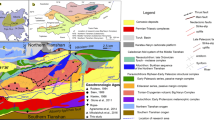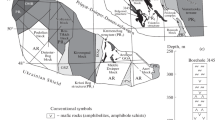Abstract
This paper presents the first geochemical, isotope-geochemical (Sm–Nd) and geochronological (U–Pb, LA–ICP–MS) data on acid volcanic rocks collected in the Bogdanikha River basin of the Priamursky fragment of the Nora–Sukhotino terrane in the northeastern South Mongolia–Khingan orogenic belt. In terms of the contents of rock-forming components, the studied volcanic rocks correspond to high-silica and high-alumina rhyolites. The elevated contents of alkalis, Ga, Zr, Nb, and Y, lower concentrations of Ba, Sr, Ti, and Eu, and mantle values of εNd(t) = +3.0…+3.6 allow the rhyolites from the Bogdanikha River basin to be classified as A2-type rhyolites. The concordant age of the youngest zircon population from the rhyolite, according to geochronological (U–Pb, LA—ICP–MS) studies, is 301 ± 4 Ma, which corresponds to the Late Carboniferous. Taking the geochemical features of the studied rhyolites and the existing models for the formation of the South Mongolia–Khingan orogenic belt into account, it is most likely that they formed in a collisional setting as a result of slab break-off.









Similar content being viewed by others
REFERENCES
Geodynamics, Magmatism, and Metallogeny of East Russia, Ed. by A. I. Khanchuk (Dal’nauka, Vladivostok, 2006), Vol. 1 [in Russian].
A. V. Grebennikov, “A-type granites and related rocks: petrogenesis and classification,” Russ. Geol. Geophys, 55 (9), 1074–1086 (2014).
L. M. Parfenov, N. A. Berzin, A. I. Khanchuk, G. Bodarch, V. G. Belichenko, A. N. Bulgatov, S. I. Dril’, G. L. Kirillova, M. I. Kuz’min, W. J. Nokleberg, A. V. Prokopiev, V. F. Timofeev, O. Tomurtogoo, and H. Jahn, “Models of the formation of orogenic belts in Central and Northeastern Asia,” Tikhookean Geol. 22 (6), 7–41 (2003).
N. N. Petruk and Yu. R. Volkova, State Geological Map of the Russian Federation. 1: 1 000 000. Sheet M-52 (Blagoveshchensk). Far East Series. Third Generation, Ed. by A. S. Vol’sky (VSEGEI. St. Petersburg, 2012) [in Russian].
Yu. F. Sidorov, State Geological Map of the USSR 1 : 200 000. Sheets M-52-VII, VIII (Sergeevka). Amur-Zeya Series, Ed. by V. V. Solov’ev (Aerogeologiya, Moscow, 1978) [in Russian].
Yu. V. Smirnov, A. A. Sorokin, and N. M. Kudryashov, “Early Paleozoic gabbro-amphibolites in the structure of the Bureya Terrane (eastern part of the Central Asian Fold Belt): first geochronological data and tectonic position,” Dokl. Earth Sci. 445 (1), 796–801 (2012).
Yu. V. Smirnov, A. A. Sorokin, A. B. Kotov, E. B. Sal’nikova, S. Z. Yakovleva, and B. M. Gorokhovsky, “Early Paleozoic monzodiorite–granodiorite association in the northeastern flank of the South Mongolia–Khingan Orogenic Belt (Nora–Sukhotinsky Terrane): age and tectonic setting,” Russ. J. Pac. Geol. 10 (2), 123–131 (2016).
Yu. V. Smirnov, A. A. Sorokin, and N. M. Kudryashov, “The first evidence for Late Devonian granitoid magmatism in the northeastern flank of the South Mongolia–Khingan Orogenic Belt,” Russ. J. Pac. Geol. 15 (1), 39–50 (2021).
A. A. Sorokin, Yu. V. Smirnov, and Yu. N. Smirnova, “Geochemical features and sources of clastic material in Paleozoic terrigenous deposits of the northeastern flank of the South Mongolia–Khingan Orogenic Belt,” Stratigraphy. Geol. Correlation 25 (2), 146–166 (2017).
V. B. Khubanov, M. D. Buyantuev, and A. A. Tsygankov, “U–Pb dating of zircons from PZ3–MZ igneous complexes of Transbaikalia by sector-field mass spectrometry with laser sampling: technique and comparison with SHRIMP,” Russ. Geol. Geophys. 57 (1), 190–205 (2016).
R. Dall’Agnol and D. C. Oliveira, “Oxidized, magnetite-series, rapakivi-type granites of Carajas, Brazil: implications for classification and petrogenesis of A-type granites,” Lithos 93, 215–233 (2007).
G. N. Eby, “Chemical subdivision of A-type granitoids: petrogenetic and tectonic implications,” Geology 20, 641–644 (1992).
Z. Q. Feng, J. Jia, Y. J. Liu, Q. B. Wen, W. M. Li, B. Q. Liu, D. Q. Xing, and L. Zhang, “Geochronology and geochemistry of the carboniferous magmatism in the northern Great Xing’an Range, NE China: Constraints on the timing of amalgamation of Xing'an and Songnen Blocks,” J. Asian Earth Sci. 113, 411–426 (2015).
B. R. Frost, C. G. Barnes, W. J. Collins, R. J. Arculus, D. J. Ellis, and C. D. Frost, “A geochemical classification of granitic rocks,” J. Petrol. 42 (11), 2033–2048 (2001).
W. Fu, H. Hou, R. Gao, J. Zhou, X. Zhang, Z. Pan, S. Huang, and R. Guo, “Lithospheric structures of the northern Hegenshan–Heihe suture: implications for the Paleozoic metallogenic setting at the eastern segment of the Central Asian Orogenic Belt,” Ore Geol. Rev. 137, 104305 (2021).
S. J. Goldstein and S. B. Jacobsen, “Nd and Sr isotopic systematic of rivers water suspended material: implications for crustal evolution,” Earth Planet. Sci. Lett. 87, 249–265 (1988).
W. L. Griffin, W. J. Powell, N. J. Pearson, and S. Y. O’Reilly, “GLITTER: data reduction software for laser ablation ICP-MS,” Laser Ablation ICP-MS in the Earth Sciences: Current Practices and Outstanding Issues, Ed. by P. J. Sylvester, Mineral. Ass. Can. Short Course Ser. 40, 204–207 (2008).
F. Guo, W. M. Fan, C. W. Li, L. C. Miao, and L. Zhao, “Early Paleozoic subduction of the Paleo-Asian Ocean: geochronological and geochemical evidence from the Dashizhai basalts, Inner Mongolia,” Sci. China D-Earth Sci. 52 (7), 940–951 (2009).
S. B. Jakobsen and G. J. Wasserburg, “Sm-Nd isotopic evolution of chondrites and achondrites,” Earth Planet. Sci. Lett. 67 (2), 137–150 (1984).
Z. Ji, W. C. Ge, H. Yang, D. X. Tian, H. J. Chen, and Y. L. Zhang, “Late Carboniferous-Early Permian high- and low-Sr/Y granitoids of the Xing'an Block, Northeastern China: implications for the Late Paleozoic tectonic evolution of the eastern Central Asian Orogenic Belt,” Lithos 322, 179–196 (2018).
R. W. Le Maitre, A. Streckeisen, B. Zanettin, M. J. Le Bas, B. Bonin, P. Bateman, G. Bellieni, A. Dudek, S. Efremova, J. Keller, J. Lameyre, P. A. Sabine, R. Schmid, H. Sorensen, and A. R. Wooley, Igneous Rocks. A Classification and Glossary of Terms. Recommendation of the International Union of Geological Science Subcommission on the Systematics of Igneous Rocks (Univ. Press, Cambridge, 2002).
Y. Li, W. L. Xu, F. Wang, J. Tang, F. P. Pei, and Z. J. Wang, “Geochronology and geochemistry of Late Paleozoic volcanic rocks on the western margin of the Songnen-Zhangguangcai Range Massif, NE China: implications for the amalgamation history of the Xing'an and Songnen–Zhangguangcai Range massifs,” Lithos 205, 394–410 (2014).
Z. X. Li, M. Cho, and X. H. Li, “Precambrian tectonics of East Asia and relevance to supercontinent evolution,” Precambrian Res. 122, 1–6 (2003).
Y. Liu, W. Li, Z. Feng, Q. Wen, F. Neubauer, and C. Liang, “A review of the Paleozoic tectonics in the eastern part of Central Asian Orogenic Belt,” Gondwana Res. 43, 123–148 (2017).
K. R. Ludwig and R. Mundil, “Extracting reliable U–Pb ages and errors from complex populations of zircons from Phanerozoic tuffs,” Geochim. Cosmochim. Acta 66, 463 (2002).
K. R. Ludwig, “Isoplot 3.6,” Berkley Geochronol. Center Spec. Publ. 4, (2008).
P. D. Maniar and P. M. Piccoli, “Tectonic discrimination of granitoids,” Geol. Soc. Am. Bull. 101, 635–643 (1989).
C. Mao, X. Lu, and C. Chen, “Geochemical characteristics of A-type granite near the Hongyan Cu-polymetallic deposit in the eastern Hegenshan-Heihe suture zone, NE China: implications for petrogenesis, mineralization and tectonic setting,” Minerals 9, 309 (2019).
W. F. McDonough and S.-S. Sun, “The composition of the Earth,” Chem. Geol. 120, 223–253 (1995).
J. A. Pearce, N. B. W. Harris, and A. W. Tindle, “Trace element discrimination diagrams for the tectonic interpretation of granitic rocks,” J. Petrol. 25 (4), 956–983 (1984).
L. Shi, C. Zheng, W. Yao, J. Li, F. Cui, F. Gao, Y. Gao, J. Xu, and X. Han, “Geochronological framework and tectonic setting of the granitic magmatism in the Chaihe-Moguqi Region, central Great Xing’An Range, China,” J. Asian Earth Sci. 113, 443–453 (2015).
S. S. Sun and W. F. McDonough, “Chemical and isotopic systematics of oceanic basalts: implication for mantle composition and processes,” Magmatism in the Ocean Basins, Geol. Soc. Spec. Publ., 42, 313–345 (1989).
Y. G. Sun, B. L. Li, F. Y. Sun, Q. F. Ding, Y. Qian, Q. L. Xu, and Y. J. Li, “Geochronology, geochemistry, and Hf isotopic compositions of Early Permian syenogranite and diabase from the northern Great Xing’an Range, northeastern China: petrogenesis and tectonic implications,” Can. J. Earth Sci. 57, 1478–1491 (2020).
Y. Tong, T. Wang, B. M. Jahn, M. Sun, D. W. Hong, and J. F. Gao, “Postaccretionary Permian granitoids in the Chinese Altai Orogen: geochronology, petrogenesis and tectonic implications,” Am. J. Sci. 314 (1), 80–109 (2014).
J. B. Whalen, K. L. Currie, and B. W. Chappell, “A-type granites: geochemical characteristics, discrimination and petrogenesis,” Contrib. Mineral. Petrol. 95 (4), 407–419 (1987).
J. B. Whalen and R. S. Hilderbrand, “Trace element discrimination of arc, slab failure, and A-type granitic rocks,” Lithos 348–349, 105179 (2019).
F. Y. Wu, D. Y. Sun, H. Li, B. M. Jahn, S. Wilde, “A-type granites in northeastern China: age and geochemical constraints on their petrogenesis,” Chem. Geol. 187, 143–173 (2002).
F. Y. Wu, D. Y. Sun, W. C. Ge, Y. B. Zhang, M. L. Grant, S. A. Wild, and B. M. Jahn, “Geochronology of the Phanerozoic granitoids in northeastern China,” J. Asian Earth Sci 41, 1–30 (2011).
J. M. Zhang, B. Xu, L. J. Yan, and Y. Y. Wang, “Evolution of the Heihe–Nenjiang Ocean in the eastern Paleo-Asian Ocean: constraints of sedimentological, geochronological and geochemical investigations from Early–Middle Paleozoic Heihe–Dashizhai orogenic belt in the northeast china,” Gondwana Res. 81, 339–361 (2020).
ACKNOWLEDGMENTS
We are grateful to collaborators of the Center for Collective Use of the Amur Center of the Mineralogical-Geochemical Studies of the Institute of Geology and Nature Management of the Far Eastern Branch of the Russian Academy of Sciences (E.N. Voropaeva, O.G. Medvedeva, V.I. Rozhdestvina, A.S. Segrenev, E.S. Sapozhnik, and E.V. Ushakova), IGC SB RAS (О.V. Zarubina, N.V. Bryanskii, T.N. Galkina) as well as staff of the Geospektr Center for Collective Use of the Geological Institute of the Siberian Branch of the Russian Academy of Sciences (Ulan Ude) for performance of the analytical studies.
Funding
The study was supported by the Russian Science Foundation (project no. 21-77-10001, https://rscf.ru/project/21-77-10001/).
Author information
Authors and Affiliations
Corresponding authors
Ethics declarations
The authors declare that they have no conflicts of interest.
Additional information
Recommended for publishing by A.I. Khanchuk
Translated by M. Bogina
Rights and permissions
About this article
Cite this article
Smirnov, Y.V., Khubanov, V.B. & Dril, S.I. Late Carboniferous Rhyolites of the Amur Fragment of the Nora–Sukhotino Terrane: Geochemistry and Geochronology. Russ. J. of Pac. Geol. 17, 501–515 (2023). https://doi.org/10.1134/S1819714023050081
Received:
Revised:
Accepted:
Published:
Issue Date:
DOI: https://doi.org/10.1134/S1819714023050081




